Interview: Torbridge Cull with Infinite Dimensions Games
If you have been looking around Kickstarter much, you would have noticed that there are a bunch of medieval towns popping up. I’ve noticed that ideas seem to cycle through the community. How does one set themselves apart from the competition? They do it by creating one of the best Kickstarters for Medieval terrain in the past two years. (When I looked back, I couldn’t believe that Wightwood Abbey funded over TWO years ago!) This Kickstarter has pretty much crushed the previous Kickstarter when it comes to funding. It’s already at nearly triple the funding of the previous Kickstarter. (in the interview I mistakenly say double, not realizing there is some currency conversion going on). Seriously, if you haven’t checked out Torbridge Cull yet, you are really missing out. This is very much like 3 individual Kickstarters with a modular bridge, the Last Hearth Inn which would be a Roleplaying Game Masterpiece, and the Fighting Pits. Oh yea, you can even download the outhouse freebie right now!
I hope you have gone ahead and checked out the Kickstarter. Learn more about the process that has brought Torbridge Cull to life in this interview.
-
What miniatures games do you play?
- To be honest we wish we had more time to play all the games we love! Designing the terrain, as fun as it it, means a lot less time for playing. As it stands we try to play Relicblade, Legion, Middle-Earth Strategy Battle, and Frostgrave when we get the chance. We also play quite a bit of Dungeons and Dragons which we use a lot of minis and terrain for.
-
How long have you owned a 3D Printer and been making terrain?
- We got our first printer, a Prusa Mk1, in early 2017. We started making terrain just a few months later.
-
What printers do you use to print terrain?
- We pretty much use Ender-3’s exclusively. The reason for this is that we want to test print our products on the same kind of machines that the majority of our customer base has. We want to make sure our products print perfectly on a $250 machine, and don’t need something high-end in order to print properly.
-
W
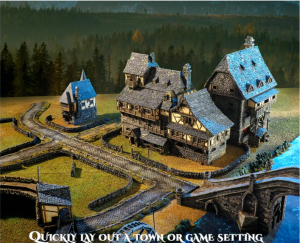 hat got you interested in modeling 3D Terrain for print? What was your first model?
hat got you interested in modeling 3D Terrain for print? What was your first model?- The possibilities of 3D-printing tabletop terrain were apparent to us from the beginning. It was easy to see that suddenly your imagination was the only limit to what you could put on the table, if you knew how to 3D-model. Luckily, we had a very strong background in 3D modelling, and so it seemed only natural to start to design our own terrain. Our first model was the basic dungeon tile set from Fat Dragon. Tom Tullis really broke the ground on 3D printing for tabletop games and we all owe him a big thanks for getting into the field when he did.
-
Do you have a favorite model you have created?
- That is a hard question to answer. If you don’t mind me saying so, we’ve done so many cool things in our models, really innovative stuff, that it’s hard to pick a favourite. But if I had to pick one, I would have to say it’s the Ancient Shrine. The design is just incredible and it is such a strong and original piece. No one who has seen that piece can forget it.
-
What are some of the challenges you run into, since your first Kickstarter?
- The second time around organizing a Kickstarter is definitely less stressful, but we had to really come up with something for round two that excelled beyond Wightwood Abbey, which wasn’t an easy task. I think we did a great job making Torbridge Cull the perfect sequel to Wightwood Abbey, and the new models are certainly pushing the envelope of what we’re developing.
- How do you find the kickstarter model, have you considered a Patreon or other subscription type model?\
-
- Kickstarter is great, and I don’t think there’s a stronger way to reach new audiences and immediately get a following. But it has it’s risks and it doesn’t allow us to consistently interact with our customers. We could very well introduce a subscription model via Patreon (or some other platform) in the future in order to release more models frequently and get more feedback from customers.
- What’s your feeling on the world of 3d Printing for games and how the industry has progressed since you last kickstarter?
-
- It’s clear that 3D printing for tabletop gaming is a match made in heaven. Giving hobbyists the ability to print the exact models they want for much cheaper than it would cost to buy a traditional model has totally changed the ‘landscape’ of tabletop gaming (forgive the pun). Honestly, the only people I know who own 3D printers are tabletop gamers! 3D printing is a real boon to the game, there’s no question about it. It’s also clear the industry has exploded since our last Kickstarter. When we did Wightwood Abbey there were about three to five 3D printing campaigns launching on Kickstarter a month, now it can be dozens! There is a ever growing range of 3D printable terrain available out there, to varying degrees of quality of course, and it gives gamers with a 3D printer a wonderful (if somewhat overwhelming at times) selection. It’s a great time to be in the industry. Designers are making some really cool models, which is awesome because it keeps upping the overall quality of the sculpts. There is also a ton of new people entering market all the time, Facebook groups for 3D printing terrain that once had 500 members a couple of years ago now have thousands! As well, printers are less and less expensive (and better in quality) and as the customer base gains in experience the pressure is on for designers to make better and better models. This is a good thing, as we all benefit from a more discerning and appreciative customer base. It will be really neat to see where this all goes in the future.
-
Torbridge Cull is a huge project and you must have been in development of it for some time. Could you walk us through just what this town is and the pieces it consists of?
- The campaign opened up by offering three distinct main core sets as well as new modular sets, all which are included in the ‘all-in pledge’. Those sets are The Last Hearth Inn, the Torbridge, the Fighting Pits and new modular rivers, roads, walls, and hedgerows. The Last Hearth Inn is a massive five story inn complex that has been designed to really be the central part of an adventure (or even campaign). The way we’ve laid out the floor plan the idea is that this is the place your adventurers will be coming back to again and again, and they’ll be facing all kinds of encounters right here in the Inn, it’s that big. The Torbridge is another really big model. We wanted to make a fortified bridge that could be expandable and be the centrepiece of a gaming table. We wanted to make a bridge that really could hold off a small army, and I think we did it. The Fighting Pits fit your quintessential medieval-fantasy gladiatorial trope. This is the kind of place we saw in the original Conan, or in Game of Thrones, or even in Gladiator (“Are you not entertained?!?”). We really wanted to give people a sizeable arena to hold large combats. With the modular sets we wanted to expand and improve upon our battlegrip modular sets we did for the last Kickstarter. The modular roads and rivers are much more organic and can be laid out anywhere on your table, not just in a grid, and the new stone walls and hedgerows work as a perfect companion to them. As for the rest of the town, it’s a place sitting right on the edge of civilization, with ties to a mysterious past. The town itself is a shadow of its former glory but some of the greatness remains. We wanted to give the impression of a town that has a history and have the buildings reflect both its illustrious past and its more spotted (and perhaps more interesting) present. There are a ton of stretch goals in this campaign and each one unlocks a bit of that history and subsequent development.
You’ve got an interesting feature in this Kickstarter, Encounter Sets. Basically you let the backers vote and decide on which sets you will include. Could you explain to our readers just what they are and how you are using them to expand on the town and your world?When we envisioned Torbridge Cull was had so many ideas, and we didn’t want to let any of them go. So we decided to let our backers decide what we would develop in the town. Basically, when we hit certain points in the funding we hold a vote on what to put up next in the stretch goals. We usually give our backers the choice of four different model sets, and we tell a bit of a story to tie them into the lore of our world. Which ever one wins the vote is the one we’ll make (if the goal is reached). By doing this we get to introduce new terrain concepts to our customer base and also kind of give them hints as to where we’re going next. This really helps us to make what people want, and it gives us a good indication of which direction to take our designs in the future. In future crowdfunding efforts we’ll draw upon this knowledge in what we develop, and maybe even bring back some of the runners up.
- The campaign opened up by offering three distinct main core sets as well as new modular sets, all which are included in the ‘all-in pledge’. Those sets are The Last Hearth Inn, the Torbridge, the Fighting Pits and new modular rivers, roads, walls, and hedgerows. The Last Hearth Inn is a massive five story inn complex that has been designed to really be the central part of an adventure (or even campaign). The way we’ve laid out the floor plan the idea is that this is the place your adventurers will be coming back to again and again, and they’ll be facing all kinds of encounters right here in the Inn, it’s that big. The Torbridge is another really big model. We wanted to make a fortified bridge that could be expandable and be the centrepiece of a gaming table. We wanted to make a bridge that really could hold off a small army, and I think we did it. The Fighting Pits fit your quintessential medieval-fantasy gladiatorial trope. This is the kind of place we saw in the original Conan, or in Game of Thrones, or even in Gladiator (“Are you not entertained?!?”). We really wanted to give people a sizeable arena to hold large combats. With the modular sets we wanted to expand and improve upon our battlegrip modular sets we did for the last Kickstarter. The modular roads and rivers are much more organic and can be laid out anywhere on your table, not just in a grid, and the new stone walls and hedgerows work as a perfect companion to them. As for the rest of the town, it’s a place sitting right on the edge of civilization, with ties to a mysterious past. The town itself is a shadow of its former glory but some of the greatness remains. We wanted to give the impression of a town that has a history and have the buildings reflect both its illustrious past and its more spotted (and perhaps more interesting) present. There are a ton of stretch goals in this campaign and each one unlocks a bit of that history and subsequent development.
-
How has your workflow changed since Wightwood Abbey?
- When we started Wightwood Abbey we were basically 3D-printing newbies ourselves. In the beginning we stumbled a lot over the basics of our designs, but now the design flow is much more spontaneous and natural. Once we have a clear idea of the model we want to make we can really get down to it as opposed to figuring out if the thing is even feasible. This allows us to be a lot more innovative in what we do, really push the envelope. In the beginning itwas like learning to walk, now it’s figuring out the best ways to run.
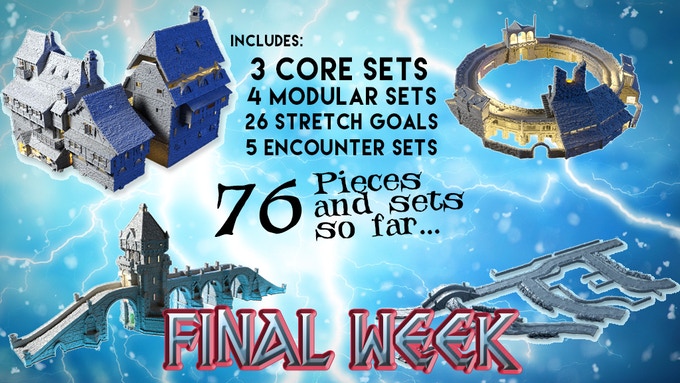
-
What software do you use for your modeling?
- Pretty much Z-brush exclusively.
- Can you tell us about some of the innovations you are integrating into this kickstarter?
-
- We love designing new ways to do things. Everything we developed for our last Kickstarter, such as the door hinges and the Battlegrip locking system, we’re using in Torbridge Cull. As far as new innovations we’ve got the fog-of-war covers, which are little covers that go over each interior room in a building, so that a dungeon master can pre-place encounters in each room and the players won’t be the wiser when the next floor of the building is lifted off. I wouldn’t be surprised if we had to come up with with new ideas during the next few months of development, and that’s part of the excitement, getting to figure out new solutions to things.
I love how you are expanding on the world you started with you last kickstarter Wightwood Abbey. Can you tell us a bit more about the world, and also, how does keeping the sets in a single world affect your design process?I talked about this a bit earlier on, but basically we find it really helpful to the creative process to have a clearly defined world (with a history and a culture and locations) that we situate our models in. When you’re designing a model, what really makes it come alive is all the detail. When we sit down to develop a model we have the whole gameworld to draw upon in terms of how to design it. So instead of just making ‘a house’ we make the house of Andor Direkin (for example), the outcast; and we know he keeps a dire wolf locked in his basement and so we put an extra reinforced door to the basement in the model. We also know he’s a real drinker, so we make sure to put a large liquor cabinet in with his furniture. We have to be careful to not make models too specific as they need to be usable over and over, but added details from the lore really helps to flesh them out and make them come alive. By keeping all the sets in a single world we can build this huge roster of ideas that influence our design process; every model ends up influencing every other model. It really helps. Also, when designing a new model we take into account the environment the building would be in and what building materials would be accessible, etc. It all has to make sense, it all has to be fit within the internal logic of the world we’ve created.
- We love designing new ways to do things. Everything we developed for our last Kickstarter, such as the door hinges and the Battlegrip locking system, we’re using in Torbridge Cull. As far as new innovations we’ve got the fog-of-war covers, which are little covers that go over each interior room in a building, so that a dungeon master can pre-place encounters in each room and the players won’t be the wiser when the next floor of the building is lifted off. I wouldn’t be surprised if we had to come up with with new ideas during the next few months of development, and that’s part of the excitement, getting to figure out new solutions to things.
- There are lots of kickstarters out there these days and plenty of models people can 3D print. How does your latest Kickstarter fill a need for people on their game table?
- Well, I’m not sure there is anything quite as grand as Torbridge Cull, which gives people a chance to put some seriously impressive models on the table. But really what we try to do with each and every model is make them different and distinct from what’s already out there. We want people to know an IDG model just by looking at it. There are plenty of medieval houses out there, but we don’t want to make just another house, we want to make something that stands out as original and possessing of a lot of character. I believe we fulfill the need of having something different than what else is our there; something that makes everyone at the table go ‘wow!’ As far as this latest Kickstarter we’re providing a comprehensive town with some really unique buildings that fill a gap in buildings we haven’t yet seen filled. We’re hoping if enough stretch goals get unlocked we’ll even go beyond the town, but that may have to wait until next time.
-
How did you come up with this idea and I think we’ve all noticed that you guys like making big models, this set you are going even bigger, I think this is something really unique about Infinite Dimensions, What’s your rational behind this?
- Torbridge Cull is pretty much Dawa’s baby. We knew we wanted to expand on the world we started creating with Wightwood Abbey, and it made the most sense to stay within Wightwood Vale and fill out that landscape before moving further afield. Later on we’ll be travelling to all kinds of different locations in the world we’re developing.
- Aside from just the ‘wow’ factor, we have always wanted to make models that are just as playable inside as they are a beautiful piece of terrain on the tabletop. We love the idea of having an encounter or battle that takes up multiple floors and rooms and just makes the scene that much more dynamic. We don’t make big models because we’re trying to be the company with the biggest models though, we always just start with a concept and it seems to require the size. For example, we wanted to design an Inn that really felt like the hub of a town, and in order to do that we had to build this entire inn complex that consists of six different buildings, some of them five stories tall! In our dreams we see incredible scenarios playing out spanning across all five buildings and out into the courtyard and beyond, and to do this it’s gotta be big!it really looks like you are continuing the aesthetic of Wightwood Abbey with your latest kickstarter is this a conscious choice to help build your overall catalogue or models?Of course. We need to be consistent. There’s a natural evolution to our models, and we’re getting better all the time at designing them, but we want to make sure we keep things familiar so that it can all work together. At a later date we’ll visit a different location in the gameworld and you’ll see a different cultural style, but it will still need to feel like it’s all connected somehow, and we do that through the design aesthetic.
-
Wightwood Abbey was an unmitigated success and this one is already almost double Wightwood Abbey. How has this met your funding goals?
- We were very careful budgeting this project to make sure we would be able to do what we set out to do. Of course we’d love to see all the stretch goals unlock, but however far we get down the list we know our funding goals have been met.
- Is there anything you would like to add about Torbridge Cull to our readers?
-
- Torbridge Cull isn’t just a random selection of medieval style buildings and terrain. First of all there’s the scale, and the attention detail but there’s also all the thought put into functionality. We design all our terrain really thinking about what gamers need when they’re playing. One thing I personally can’t stand is a piece of terrain that looks like I should be able to put a mini somewhere, but I can’t. All our doorways, balconies, outcroppings, nooks and crannies, everything, it’s all designed so that you can use them during play. So there’s that, but also there’s the fact that Torbridge Cull, Wightwood Abbey, everything we do, is connected by a story. You don’t have to use the story in your games, but each of our terrain pieces works with every other piece. Nothing is random. If you see a certain motif on the wall of one building, that motif means something and you’ll likely see it repeated elsewhere. This allows dungeon masters to appropriate our symbology and other story elements and adapt them to some aspect of their own game. Torbridge Cull is kind of a sequel to Wightwood Abbey, and the story just keeps getting richer. In terms of the models that are in Torbridge Cull, I think I can say safely that they’re even better than the models we did for Wightwood Abbey. This is our sophomore project, and we’ve learned so much from our first one which has made designing Torbridge Cull more fun and allowed us to be more creative. There’s a lot on offer in this campaign, and I’m really excited to see where we can go by the end of it.
- What’s next for Infinite Dimensions Games, will you stay in the same genre, the same world of venture into something else?
-
- Unless some idea comes along that is too good to pass up, we’ll be staying in the same genre. We’ll probably move our location farther away from Wightwood Vale and focus on a new area of the world. We love the vale, but even we need to move on.
Thanks to Dawa and James for taking some time out of their incredible Kickstarter to answer some questions about their Kickstarter and their creative process. This sophomore outing from Infinite Dimensions Games shows how far they have come in the past couple of years. I still count Wightwood Abbey as one of my favorite terrain sets out there, and this one really does take it up a notch (or three). Remember, if you missed out on Wightwood Abbey, you can pick it up as addons to this Kickstarter as well.
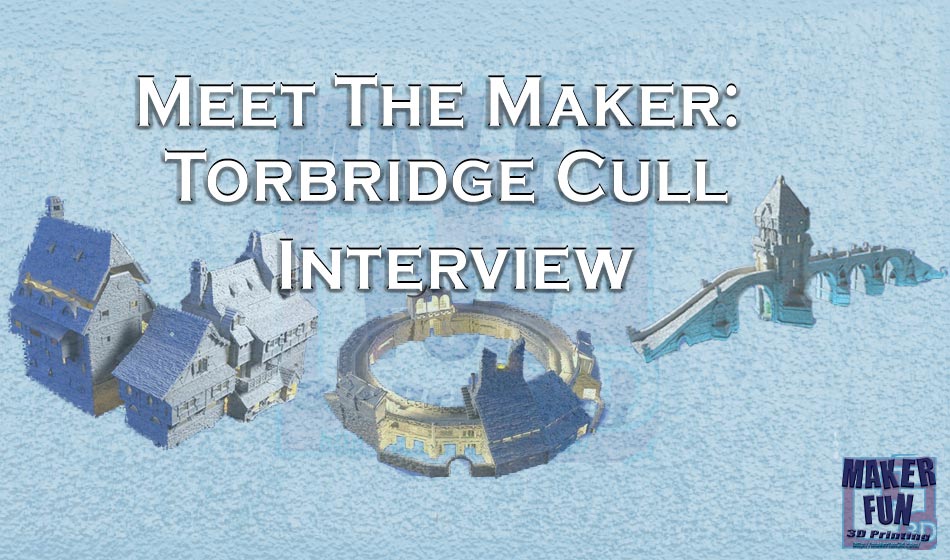

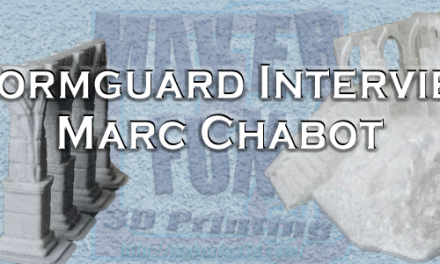
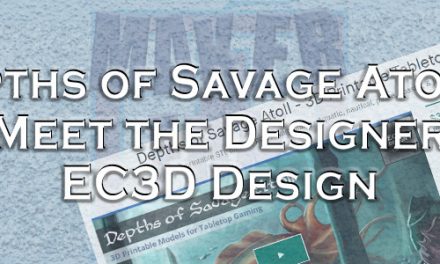
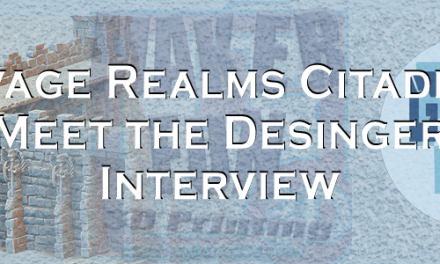
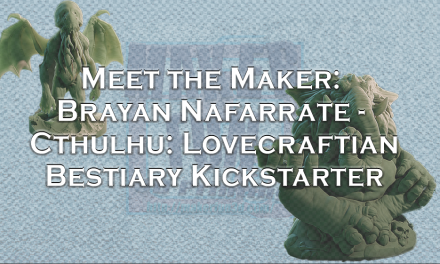

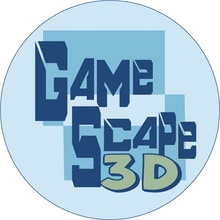
Trackbacks/Pingbacks